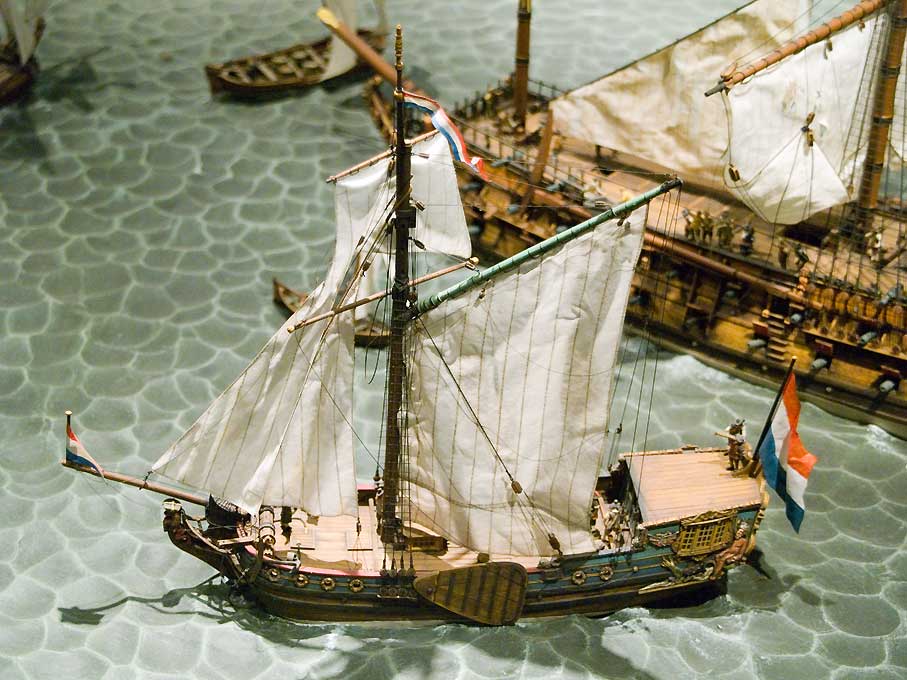Until
the advent of steam trains and motor cars in many areas around Europe
water transport was the fastest and most comfortable way of travelling.
If one looks at maps of the Netherlands from 300 or 400 years ago it is
very obvious that water transport was the means of choice for all
classes of travellers. Even today, after the extensive programmes of
diking that set in in the 1500s, it is still possible to go by boat to
many places in the Low Countries. For many centuries regular boat
services along the canals, rivers and across wider stretches of open
waters, such as the Zuiderzee, were covered by regular boat services.
On inland water ways these were the 'trekschuit', narrow boats with a
cabin towed usually by horses and on the open water the 'buurtschepen'
(literally 'neighbourhood boats'), sailing boats of various
description, such as boeiers. There were, of course, also individual
boats for hire and more affluent people would keep their own boats.
The
Mercedes and Rolls Royce of the day was the 'statenjacht' or other,
more modest types of 'jacht', such as 'pavilioenjacht'. They were
single-masted ships of 15 to 30 m length and usually highly decorated
according to the contemporary fashion. Owners were affluent private
persons or more likely companies, such as the
Verenigde
Oost-Indische Compagnie (VOC), and corporations, such as the town
councils of Amsterdam, Rotterdam or Antwerp. The 'statenjacht'
was used as would be 'official' cars today, to move company executives
or dignitaries from place to place so that they could execute their
business. Another use was to entertain these people and their guests.
For this purpose they were fitted out with
state
cabins,
kitchens, bedrooms and other relevant amenities. Statenjachten, some of
them being good sailors, were also used as reconnaissance and dispatch
boats in a naval context, notably during the Dutch-English wars in the
17th century. Statenjachten stand at the beginning of pure
pleasure-boating too.
 |
 |
 |
 |
 |
 |
 |
 |
F.C. van Douwe (1659-1735)
© Maritiem Museum Rotterdam
|
H.
Dubbels (1621-1707)
© National Gallery London
|
L.
Bakhuizen (1631-1708)
© National Maritime Museum Greenwich
|
W. van den Velde the Younger
(1633-1707)
© National Maritime Museum Greenwich
|
L.P.
Verschuier
(1630-1686)
© National Maritime Museum Greenwich |
S. de
Vlieger
(1601-1653)
© National Maritime Museum Greenwich
|
W.
van den Velde the Younger
(1633-1707)
© private collection
|
D.
Kleyne
(1753-1805)
© National Maritime Museum Greenwich |
There are estimations that between 1600 and 1800 around 200
statenjachten were built in the Netherlands. The last specimen survived
in the Dutch navy until 1843.
The general layout of the statenjacht has not dramatically changed over
the roughly 250 years of its development and use, i.e. from the mid
16th century to the early 19th century. Interestingly, apart from
changes in the style and extent of sculptural decoration the most
notable change is the adoption of the gaff rig in place of the
spritsail at the end of the 17th century. There are, of course, changes
in other details of rigging too.
As royalty around Europe became to know these jachts, a luxury export
market developed. Some where also given away as stately presents by the
Dutch Governments. Thus 17th and 18th century kings of England,
Prussia, Sweden and Russia had yachts of Dutch origin, some of which
were later copied and adapted to the navigational needs in the
respective territorial waters.
The statenjacht as a type of boat was
developed at a time when
shipbuilding drawings were not normally used. Therefore their early
history is only known through artistic representations. There are
numerous paintings and drawings that show statenjachten. Some of these
visual representations are more concerned with the decoration, having
served indeed as design studies, rather than with the technical details
of construction. From the beginning of the 18th century on technical
drawings become available.
Utrecht, unlike other cities such as
Amsterdam or Rotterdam,
apparently never
owned a statenjacht of this type (though Utrecht did have trekschuiten
and the like). However, in the late 1990s a group of people in Utrecht
decided to develop a reconstruction of a statenjacht that completed in
2003 eventually
became known as the '
Utrecht
Statenjacht'. The sources collected in developing this free
reconstruction are discussed in
HOVING
(2008). The starting point was a drawing by Pieter van Zwijndregt in
the Rotterdam Maritime Museum, dated 1746. Other details, including the
sculptural decoration and colouring scheme were developed from
contemporary sources. The material used in the reconstruction of the '
Utrecht Statenjacht' is collated
on a DVD that is available through their
Web-site.
The model is based on the resin kit
produced
by
Artitec in
1:90 (HO) scale.
This company has developed a real mastery in casting complex and large
resin parts. In addition to the hull, the kit contains castings for
various deck features, guns and carriages, for rigging blocks,as well
as the
mast and spars. The kit also contains a small fret of etched parts,
mainly for
the ironwork of the rigging. While the etched parts are well made as
such, they
are for the most part not really useful for representing the forged
ironwork. For instance, mast hoops are, of course, flat in the
horizontal direction, while they should really be short tubes. Other
parts simply lack the needed plasticity. Hence most of the etched parts
will not be used. Similarly, the cast rigging blocks will be replaced
by
home-made ones. Various other details
will be improved for better definition of the shapes. Although the
casting is well made, there are certain limitations due to the casting
process. A company policy of
Artitec
is to limit the number of parts and to cast-on as many details as
possible. There
are limitations to undercuts in the silicone rubber moulds. So some
additional engraving will be needed.


















